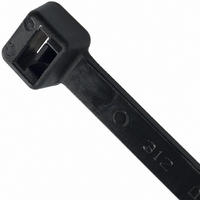PLT1M-M00 Panduit Corp, PLT1M-M00 Datasheet - Page 65

PLT1M-M00
Manufacturer Part Number
PLT1M-M00
Description
CABLE TIE MINI WR BLK 3.9"
Manufacturer
Panduit Corp
Series
PAN-TY®r
Type
Locking Cable Tier
Specifications of PLT1M-M00
Color
Black
Wire/cable Tie Type
Standard, Locking
Bundle Diameter
0.87" (22.10mm)
Length
0.325' (99.06mm, 3.90")
Width
0.098" (2.50mm)
Mounting Type
Free Hanging (In-Line)
Tensile Strength
18 lbs. (8.2 kg)
Features
Weather Resistant
Body Material
Nylon 6.6
Operating Temp Range
-40C to 85C
Product Length (mm)
99mm
Product Depth (mm)
4.6mm
Product Height (mm)
3.9mm
Maximum Bundle Diameter
0.87 in
Product
Cable Ties
Lead Free Status / Rohs Status
Lead free / RoHS Compliant
Material Failure Testing
*HALAR is a registered trademark of Solvay Solexis, Inc.
**TEFZEL is a registered trademark of E. I. DuPont de Nemours Co.
Property decay can lead to three different modes of failure: loss of strength, loss of toughness or change
in appearance. The critical mode for any given application would depend upon the application and the
requirements it places upon the material itself.
Loss of strength is monitored by tensile testing samples of the material before and after it has been
weathered. This test will reveal the decreasing strength accompanied by extended weathering.
Loss of toughness can be monitored by measuring changes in elongation and impact strength. As
ultraviolet light exposure time increases and the material becomes brittle, its elongation and impact
strength are greatly reduced. It is important to note that brittle failures can occur even when the tensile
strength shows no change.
Although change in appearance is normally not a failure mode for cable ties, the plastic does tend to
discolor and lose its surface gloss as exposure increases. These changes can be measured by color
difference using Adams units which are similar to National Bureau of Standard units.
PANDUIT
materials.This includes examining many previously aged samples obtained throughout the world.
In all cases, the amount of property decay increased with increasing exposure to ultraviolet light. The
principal signs of degradation were found to be brittleness, cracking and loss of surface gloss. It was also
determined that the time for failure to occur was shorter than indicated from industry tests performed on
material samples. This discrepancy is in part due to the fact that cable ties were tested in an end use,
stressed condition, while most plastic resin suppliers conduct weathering tests using unstressed
test bars.
Four cable tie materials (TEFZEL**, HALAR*, Weather Resistant ACETAL and Stainless Steel) have
superior ultraviolet light resistance. In tests conducted to date, all have shown no significant signs
of degradation.
Determining the outdoor life expectancy of any material is difficult since there are other factors, besides
ultraviolet light stability, which have to be considered. These factors are listed below and should be
considered before specifying a cable tie material.
Chemicals
Bundle
Diameter
Loading
Thickness
Vibration
Degree of
Exposure
Moisture
Galvanized
Metals
FACTORS
TABLE A — External Factors Which Affect the Life of a Cable Tie
®
Applications which have chemicals present can reduce the life. This is
the most detrimental factor to the life of a tie.
As the bundle diameter is reduced, the tie has more bending stress.
A thick strap on small diameter has more stress.
If the tie is under high loading, this will add additional stress on the
tie body.
A thinner tie will have a decreased life since surface cracks will
penetrate the thickness of the tie faster.
Applications with high vibrations will cause impact which will
propagate any surface cracks.
No shield or shade, southern exposure, higher altitudes and high
temperatures decrease the life of the cable tie.
Dry environments cause nylon 6.6 ties to become more brittle. High
humidity plus high temperatures can result in degradation due to
hydrolysis in nylon.
Acid rain and acid moisture acting on galvanized metals release
chemicals known to attack nylon 6.6.
DECREASED LIFE
has its own weathering test program to determine estimated life of various cable tie
Weathering
*Based on assumption of minimum loading, no chemical attack and
impact-free conditions.
Natural Polypropylene (-109)
Natural Nylon 6.6
Flame Retardant Black Nylon 6.6 (-60)
Flame Retardant Nylon 6.6 (-69)
Heat Stabilized Nylon 6.6 (-30)
Heat Stabilized Natural Nylon 6.6 (-39)
Weather Resistant Nylon 6.6 (-0 & -00)
Heat Stabilized Weather Resistant Nylon 6.6 (-300)
Weather Resistant Polypropylene (-100)
Weather Resistant Nylon 12 (-120)
TEFZEL** (-76)
HALAR* (-702)
Acetal
Stainless Steel (MLT prefix)
Materials (P/N Suffix)
WEATHERING LIFE EXPECTANCY
Most commonly used parts appear in BOLD.
Years*
12-15
>15
>15
>20
>30
1-2
1-2
1-2
4-5
1-2
7-9
7-9
7-9
1
65










